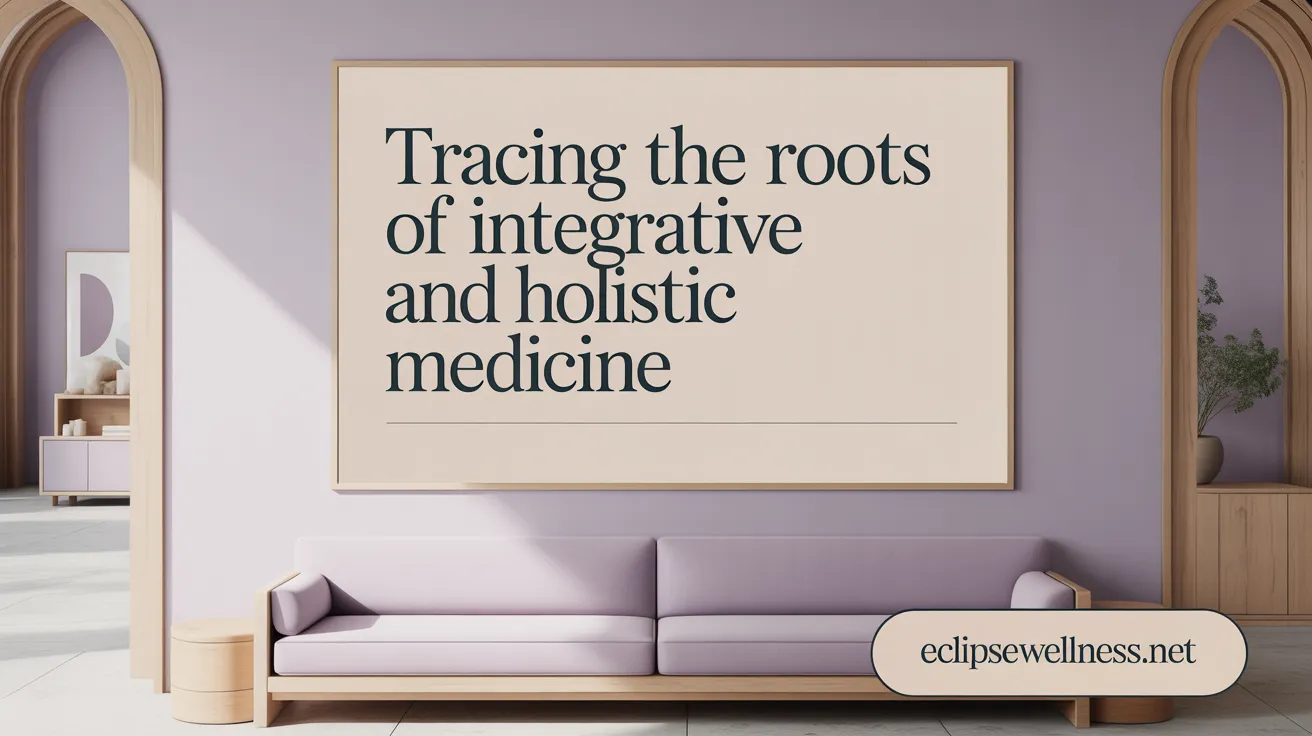Understanding the Growing Influence of Holistic Practices
Over recent decades, holistic practices—often categorized under complementary and alternative medicine (CAM)—have profoundly influenced healthcare worldwide. As patients and providers alike seek more comprehensive care, these practices are increasingly recognized for their potential to complement conventional medicine. This article provides an overview of holistic practices, highlighting their definitions, roles, historical development, integration into healthcare systems, and the crucial role of evidence-based research in ensuring their safe and effective use. We also explore the benefits and safety considerations of combining these approaches with traditional medical treatments, illustrating a future where whole-person health is central to healthcare delivery.
Defining Complementary and Alternative Medicine: Types and Classifications
Complementary and alternative medicine (CAM) encompasses a broad array of medical practices, products, and systems that are not traditionally part of mainstream Western medicine. It can be categorized into five main types, each serving different roles in health management.
Firstly, mind–body therapies such as meditation, yoga, hypnotherapy, and biofeedback focus on the connection between mental and physical health. These practices aim to reduce stress, alleviate pain, and improve emotional well-being.
Secondly, biologically based practices include herbal medicines, dietary supplements, vitamins, minerals, and probiotics. These are used to improve nutritional status, bolster immune health, or address specific ailments.
Thirdly, manipulative and body-based practices involve physical manipulation and contact, like massage therapy, chiropractic adjustments, acupuncture, reflexology, and cupping. These are often employed to relieve musculoskeletal issues, enhance circulation, and promote relaxation.
Fourth, energy therapies such as Reiki, Qigong, therapeutic touch, and magnets work on the concept of external or internal energy fields influencing health. Though evidence varies, some individuals find these helpful for emotional and physical balance.
Lastly, whole medical systems like Ayurveda, traditional Chinese medicine, homeopathy, and naturopathy are comprehensive frameworks that include multiple modalities for diagnosis and therapy, emphasizing holistic care.
The distinction between complementary, alternative, and integrative medicine is crucial. Complementary approaches are used alongside conventional treatments to support health, while alternative practices replace standard care. Integrative medicine combines both conventional and CAM practices in a coordinated way, focusing on whole-person health—body, mind, and spirit.
These practices often emphasize holistic health, aiming not only to treat specific conditions but also to enhance overall well-being and prevent illness. As they gain acceptance, understanding their classifications and evidence basis helps guide safe usage and effective integration into healthcare routines.
Historical Evolution of Integrative and Holistic Medicine

How have integrative medicine and holistic practices developed historically?
Integrative medicine and holistic health principles have ancient origins, rooted in traditional healing practices from civilizations like Egypt, India, China, Greece, and during the Islamic Golden Age. These cultures emphasized natural remedies, spiritual well-being, and the concept of vital energy or life force. Such practices aimed to treat the whole person—body, mind, and spirit—rather than just isolated symptoms.
In the late 19th and early 20th centuries, this holistic perspective gained organized form through figures like Benedict Lust, who popularized naturopathy and organic healing. During this period, there was a shift toward drugless, natural methods, reflecting an interest in preventative care and natural therapies.
The modern framework of integrative medicine emerged prominently in the late 20th century. Organizations such as the American Holistic Medicine Association, founded in 1978, and the American Holistic Nurses Association, established in 1979, promoted a comprehensive approach that includes mental, physical, and spiritual health.
From the 1990s onward, formal training programs, certification bodies, and research institutions began to develop around integrative medicine. Notable examples include the American Board of Integrative Holistic Medicine, established in 2000, and the growth of the Academy of Integrative Health & Medicine (AIHM). These milestones marked its recognition as a distinct, evidence-informed medical discipline.
Today, the evolution continues as integrative medicine integrates scientific research with traditional practices. It emphasizes personalized, patient-centered care that promotes wellness and preventative strategies, drawing from both modern science and historical healing wisdom.
Evidence-Based Research: Validating Holistic Therapies

What is the role of evidence-based research in evaluating the effectiveness of holistic therapies?
Evidence-based research is fundamental in assessing the true value of holistic therapies. By applying scientific methods, it ensures that practices like meditation, yoga, acupuncture, and creative arts therapies are safe and effective for patients.
This research guides healthcare providers in choosing therapies supported by solid evidence, allowing them to incorporate these practices into conventional treatment plans confidently. It also helps personalize care, addressing individual patient needs by combining proven holistic approaches with standard medical techniques.
Over the past decades, many therapies have gained recognition through rigorous studies, mainly randomized controlled trials, systematic reviews, and meta-analyses. These methodologies reduce bias and provide reliable data on the benefits and potential risks of therapies.
For example, acupuncture has been shown to relieve certain types of pain, while mindfulness and yoga have demonstrated success in improving mental health and reducing stress. Such evidence supports their integration into mainstream healthcare.
However, some CAM therapies still face challenges due to variability in study quality, lack of standardization, and difficulties in blinding or placebo control. Despite these hurdles, ongoing research continues to bolster the scientific basis of many practices.
Governments and academic institutions play vital roles in this process. Agencies like the National Institutes of Health (NIH), through centers like the National Center for Complementary and Integrative Health (NCCIH), fund research projects, support clinical trials, and develop guidelines for safe practice.
Academic medical centers, such as Mayo Clinic and Memorial Sloan-Kettering, also contribute by conducting independent studies and providing evidence-based information. These efforts ensure that only therapies with demonstrated safety and benefit become part of standard care.
In summary, rigorous evidence-based research is key to validating holistic therapies. It helps bridge the gap between traditional practices and modern medicine, promoting safer, more effective integrative healthcare tailored to individual needs.
Integrating Holistic Practices into Conventional Healthcare Systems

How are holistic practices integrated into conventional healthcare systems?
The integration of holistic practices into mainstream healthcare is evolving rapidly, aiming to provide more comprehensive and patient-focused care. Models of integrative healthcare delivery combine evidence-informed complementary therapies with conventional treatments, emphasizing the importance of treating the whole person—body, mind, and spirit.
In practice, this integration involves incorporating therapies such as acupuncture, herbal medicine, yoga, and mindfulness into treatment plans. These practices are backed by research supporting their safety and effectiveness, and are used alongside standard medical procedures like medication, surgery, and radiation.
Healthcare providers play a crucial role in this process. Many are receiving education through medical curricula and ongoing training to understand and apply holistic approaches safely. This knowledge enables them to recommend or refer patients to appropriate CAM therapies, ensuring coordinated and personalized care.
Facilities dedicated to integrative medicine are being established, equipped with the necessary infrastructure for safe practice. Referral systems are also developed to facilitate smooth patient transitions between conventional and complementary services. Rigorous scientific studies, including randomized controlled trials, are essential to validate the efficacy of these therapies and foster broader acceptance.
International organizations such as the World Health Organization (WHO) have issued guidelines and strategies to support the integration process. The WHO’s Traditional Medicine Strategy 2025–2034 promotes culturally respectful, evidence-based incorporation of traditional, complementary, and integrative practices into national health systems.
Ultimately, integrating holistic practices into conventional healthcare aims to enhance health outcomes, reduce disparities, and promote overall wellness. This approach shifts the focus from disease management alone to a broader perspective that considers the person in their entirety, fostering improved patient satisfaction, safety, and quality of life.
| Aspect | Description | Additional Details |
|---|---|---|
| Models of delivery | Combining conventional and CAM therapies | Focus on patient-centered, holistic care |
| Treatment incorporation | Use of therapies like acupuncture, herbal remedies | Evidence-based practices integrated with standard care |
| Provider education | Medical training and professional development | Ensuring safe and effective therapy recommendations |
| Facility development | Establishment of specialized clinics and referral systems | Support for coordinated integrative services |
| International guidelines | WHO strategies and policies | Promote safe, effective, and culturally appropriate integration |
Benefits and Safety Considerations of Combining Holistic and Conventional Medicine

What are the benefits of combining holistic practices with conventional medical treatments?
Combining holistic practices with conventional medicine provides a comprehensive approach to health, tackling physical, mental, emotional, and spiritual well-being. Integrative medicine focuses on personalized care, tailoring treatments to individual needs by using evidence-based therapies such as acupuncture, meditation, herbal remedies, and nutritional guidance alongside standard interventions.
This combined approach can lead to better health outcomes, help manage symptoms more effectively, and improve overall quality of life. For example, cancer patients often use mind-body techniques like meditation to reduce stress and pain alongside chemotherapy. It emphasizes prevention, encourages self-care, and supports whole-person health.
Furthermore, integrating these therapies fosters a collaborative relationship between patients and healthcare providers. While many CAM therapies have demonstrated promising benefits, ongoing research continues to substantiate their safety and efficacy within mainstream healthcare.
Holistic Health in Practice: Contemporary Applications and Patient Perspectives

Use of CAM in managing chronic and complex illnesses
Complementary and alternative medicine (CAM) is increasingly used to support the management of chronic and complex health conditions. Practices such as acupuncture, herbal medicine, and mind-body therapies like meditation and yoga help alleviate symptoms, reduce stress, and improve overall well-being. Integrative medicine combines these therapies with conventional treatments to offer more comprehensive, patient-centered care.
Examples of symptom relief and quality-of-life improvement
Patients undergoing treatments for cancer, chronic pain, or arthritis often turn to CAM for relief. For example, acupuncture and massage therapy can reduce pain and tension, while meditation and mindfulness practices help decrease anxiety and improve mental health. These therapies can enhance quality of life, support emotional resilience, and promote faster recovery.
Patient usage statistics and cultural considerations
Recent surveys indicate that about 38% of adults and up to 12% of children in some regions use CAM therapies. Cultural beliefs heavily influence CAM acceptance; for instance, in countries like Saudi Arabia, traditional medicine rooted in religious practices plays a significant role. Recognizing these cultural factors helps healthcare providers personalize and adapt integrative approaches.
Collaborative care models and integrative clinics
Many healthcare systems now incorporate integrative clinics, where conventional doctors and CAM practitioners work together. These models foster open communication, optimize treatment plans, and ensure safety. Institutions like the Mayo Clinic and Memorial Sloan-Kettering Cancer Center offer specialized programs that combine science-based CAM therapies with standard care.
Resources for patients and practitioners
Patients and providers can access a wealth of resources, including the National Cancer Institute, NCCIH, and MedlinePlus, which offer evidence-based information on CAM practices. Educational programs and clinical trial opportunities help advance the scientific understanding and safe integration of holistic health practices.
Toward a Future of Integrated, Whole-Person Healthcare
Holistic practices hold a vital place alongside conventional medicine, embodying a shift toward more inclusive, evidence-informed healthcare that values the whole person—body, mind, and spirit. Through historical perseverance and growing scientific validation, integrative medicine offers promising pathways to enhance patient-centered outcomes, foster self-care, and address complex health challenges more effectively. Safety and regulatory measures remain essential as these therapies gain wider acceptance, ensuring optimal coordination between practitioners and patients. As healthcare systems increasingly embrace these complementary approaches, a balanced partnership between tradition and innovation emerges—one that promises a more resilient and holistic future in health and healing.
References
- Evidence-Based Complementary and Alternative Medicine ...
- Complementary, Alternative, or Integrative Health: What's ...
- Types of Complementary and Alternative Medicine
- Complementary, alternative, and integrative medicine ...
- Complementary and Alternative Medicine (CAM)
- Complementary and Alternative Medicine (CAM): Resources
- Traditional, Complementary and Integrative Medicine
- Integrative Medicine and Health - Overview
- The brief history of complementary, alternative, and ...
